I am working on an android app with DB operations. And for debugging purpose I have installed the SQLite browser from here enter link description here. My problem is that when I export my db file from the emulator and open it in the browser it only shows meta data but not my actual app data.enter image description here
And yes I have exported the db file from correct location using the Android Device Manager.enter image description here
And as you can see there are some other files also created in the database folder(journal & .file). So I was wondering if anybody knows if there is any change in how the data is stored in the SQLite DB recently. I am using Android Studio 3.0.1.
Thanks in advance for the help.
Here is the new screenshot with the package name.enter image description here
Logs from the Common SQLite utility
D/SQLITE_CSU: logCursorColumns invoked. Cursor has the following 4 columns.
D/SQLITE_CSU: Column Name 1 is id
D/SQLITE_CSU: Column Name 2 is title
D/SQLITE_CSU: Column Name 3 is uid
D/SQLITE_CSU: Column Name 4 is address
D/SQLITE_CSU: logCursorData Cursor has 1 rows with 4 columns.
D/SQLITE_CSU: Information for row 1 offset=0
For Column id Type is INTEGER value as String is 1 value as long is 1 value as double is 1.0
For Column title Type is STRING value as String is BBC value as long is 0 value as double is 0.0
For Column uid Type is STRING value as String is PajUFVIZvKbNWAHAgdJ9xpf6gi33 value as long is 0 value as double is 0.0
For Column address Type is STRING value as String is http://feeds.bbci.co.uk/news/world/rss.xml value as long is 0 value as double is 0.0
Here is the logDatabaseInfo log "-
D/SQLITE_CSU: DatabaseList Row 1 Name=main File=/data/data/com.rss.feedster.rss_feedster/databases/rssFeeds
D/SQLITE_CSU: Database Version = 3
D/SQLITE_CSU: Table Name = android_metadata Created Using = CREATE TABLE android_metadata (locale TEXT)
D/SQLITE_CSU: Table = android_metadata ColumnName = locale ColumnType = TEXT Default Value = null PRIMARY KEY SEQUENCE = 0
D/SQLITE_CSU: Table Name = feeds Created Using = CREATE TABLE feeds(id INTEGER PRIMARY KEY,title TEXT,uid TEXT,address TEXT)
D/SQLITE_CSU: Table = feeds ColumnName = id ColumnType = INTEGER Default Value = null PRIMARY KEY SEQUENCE = 1
D/SQLITE_CSU: Table = feeds ColumnName = title ColumnType = TEXT Default Value = null PRIMARY KEY SEQUENCE = 0
D/SQLITE_CSU: Table = feeds ColumnName = uid ColumnType = TEXT Default Value = null PRIMARY KEY SEQUENCE = 0
D/SQLITE_CSU: Table = feeds ColumnName = address ColumnType = TEXT Default Value = null PRIMARY KEY SEQUENCE = 0
D/SQLITE_CSU: Table Name = user_info Created Using = CREATE TABLE user_info(id INTEGER PRIMARY KEY,uid TEXT,nickname TEXT,email TEXT,age TEXT,mobile TEXT,password TEXT,gender TEXT,photoURL TEXT)
D/SQLITE_CSU: Table = user_info ColumnName = id ColumnType = INTEGER Default Value = null PRIMARY KEY SEQUENCE = 1
D/SQLITE_CSU: Table = user_info ColumnName = uid ColumnType = TEXT Default Value = null PRIMARY KEY SEQUENCE = 0
D/SQLITE_CSU: Table = user_info ColumnName = nickname ColumnType = TEXT Default Value = null PRIMARY KEY SEQUENCE = 0
D/SQLITE_CSU: Table = user_info ColumnName = email ColumnType = TEXT Default Value = null PRIMARY KEY SEQUENCE = 0
D/SQLITE_CSU: Table = user_info ColumnName = age ColumnType = TEXT Default Value = null PRIMARY KEY SEQUENCE = 0
D/SQLITE_CSU: Table = user_info ColumnName = mobile ColumnType = TEXT Default Value = null PRIMARY KEY SEQUENCE = 0
D/SQLITE_CSU: Table = user_info ColumnName = password ColumnType = TEXT Default Value = null PRIMARY KEY SEQUENCE = 0
D/SQLITE_CSU: Table = user_info ColumnName = gender ColumnType = TEXT Default Value = null PRIMARY KEY SEQUENCE = 0
D/SQLITE_CSU: Table = user_info ColumnName = photoURL ColumnType = TEXT Default Value = null PRIMARY KEY SEQUENCE = 0




